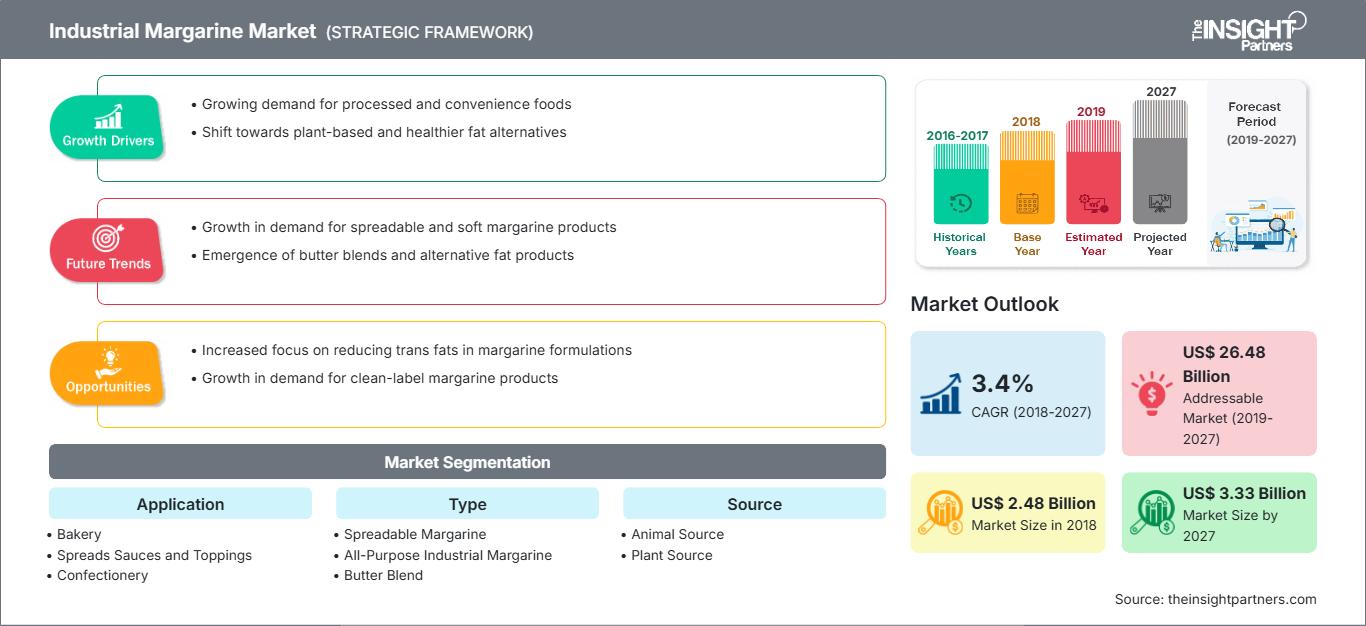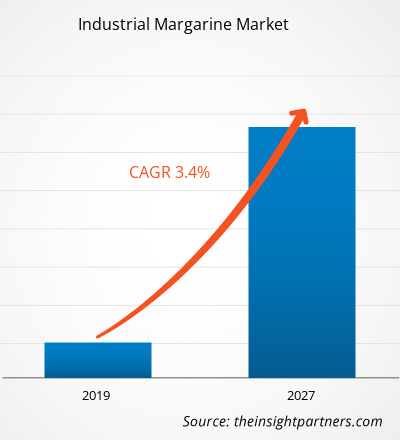[Rapport de recherche] Le marché de la margarine industrielle était évalué à 2 480,0 millions de dollars américains en 2018 et devrait atteindre 3 330,4 millions de dollars américains d'ici 2027 ; il devrait croître à un TCAC de 3,4 % entre 2019 et 2027.
La margarine industrielle est un produit laitier utilisé comme substitut du beurre. Bien que la margarine industrielle et le beurre soient tous deux utilisés pour rehausser le goût de divers plats, ils présentent des caractéristiques distinctes. Le beurre est composé d'eau, de protéines et de matière grasse, tandis que la margarine industrielle est composée de graisses animales et/ou d'huiles végétales transformées.
Le marché de la margarine industrielle en Amérique du Nord devrait connaître son plus fort TCAC au cours de la période de prévision. La croissance du marché dans cette région est principalement attribuée à la prévalence croissante de maladies telles que le diabète, l'hypertension artérielle et la constipation, les consommateurs étant de plus en plus soucieux de leur santé. De ce fait, les producteurs alimentaires américains se concentrent sur la fabrication de margarines sans gras trans. La demande croissante de margarine industrielle est alimentée par le lancement de nouveaux produits de margarine modifiée, comme les pâtes à tartiner allégées ou sans gras, et la margarine enrichie en lait enrichi en vitamine D. La demande croissante de margarine industrielle en Amérique du Nord a incité les fabricants à s'implanter dans la région, ce qui a encore stimulé la croissance du marché de la margarine industrielle en Europe.
Vous bénéficierez d’une personnalisation sur n’importe quel rapport - gratuitement - y compris des parties de ce rapport, ou une analyse au niveau du pays, un pack de données Excel, ainsi que de profiter d’offres exceptionnelles et de réductions pour les start-ups et les universités
Marché de la margarine industrielle: Perspectives stratégiques

-
Obtenez les principales tendances clés du marché de ce rapport.Cet échantillon GRATUIT comprendra une analyse de données, allant des tendances du marché aux estimations et prévisions.
L'épidémie de COVID-19 a des répercussions négatives sur les économies et les industries de divers pays en raison des confinements, des interdictions de voyager et des fermetures d'entreprises. L'alimentation et les boissons comptent parmi les industries importantes qui souffrent de graves perturbations, telles que les restrictions sur la chaîne d'approvisionnement et la fermeture des usines de production. Les effets mondiaux de la maladie à coronavirus 2019 (COVID-19) se font déjà sentir, et la demande de margarine en bloc en 2020 sera considérablement affectée. La COVID-19 a influencé le comportement et la demande des consommateurs, les habitudes d'achat, la réorientation de la chaîne d'approvisionnement, la dynamique du marché et l'ingérence des gouvernements. Ainsi, ces facteurs freinent la croissance du marché de la margarine industrielle dans l'industrie agroalimentaire.
Aperçu du marché : La demande croissante d'aliments hypocaloriques devrait stimuler la croissance du marché de la margarine industrielle
Le marché de la margarine industrielle est en croissance en raison de la demande croissante d'aliments et de boissons faibles en matières grasses, conséquence de l'évolution des modes de vie et d'une prise de conscience croissante des problèmes de santé. Les jeunes sont de plus en plus conscients des bienfaits d'une alimentation équilibrée pour la santé, notamment pour éviter l'obésité et le diabète. La croissance du marché devrait être favorisée par l'augmentation du nombre d'aliments hypocaloriques proposés par les supermarchés, ainsi que par les efforts importants de recherche et développement déployés par les fabricants pour élargir leur gamme de produits et vendre de meilleurs produits à bas prix. Vandemoortele, Unilever Plc, Richardson International Limited et Conagra Brands, Inc. comptent parmi les principaux fabricants de margarine industrielle. Leurs produits hypocaloriques séduisent les jeunes générations soucieuses de leur santé.
Aperçu des types
Selon les types, le marché de la margarine industrielle se divise en deux catégories : la margarine tartinable, la margarine industrielle tout usage et le mélange de beurre. Le segment de la margarine industrielle tartinable représentait une part de marché plus importante en 2018. Comparée au beurre, la margarine industrielle offre une meilleure tartinabilité à température ambiante. Grâce à sa meilleure tartinabilité, la margarine est devenue une tartinable plus populaire et moins coûteuse. La margarine industrielle est encore couramment utilisée pour tartiner des toasts et du pain. Elle est fréquemment utilisée comme substitut au beurre, plus coûteux, grâce à son onctuosité et à sa texture crémeuse. Les margarines à tartiner sont souvent faibles en cholestérol et en gras trans, ce qui en fait une alternative équilibrée. Le faible taux de cholestérol LDL de la margarine industrielle devrait stimuler le marché, car elle est de plus en plus consommée par des consommateurs soucieux de leur cholestérol.
Ainsi, tous ces facteurs devraient stimuler la demande de margarine industrielle au cours de la période de prévision.
Aperçu des applications
Selon les applications, le marché de la margarine industrielle est segmenté en boulangerie, pâtes à tartiner, sauces et garnitures, confiserie, plats cuisinés, etc. Le segment de la boulangerie représentait la plus grande part de marché en 2018. La margarine pour croissants, la margarine feuilletée dure, la margarine pour crème au beurre, la margarine pour gâteaux et la margarine pour pâte feuilletée sont les types de margarine industrielle les plus populaires utilisés dans l'industrie de la boulangerie. La margarine est utilisée pour rendre la pâte de blé tendre dans une variété de produits de boulangerie. Les boulangers préfèrent la margarine en raison de sa texture moelleuse, qui facilite la préparation d'un glaçage à la crème au beurre ou d'un sucre crémeux pour un gâteau éponge. Les viennoiseries danoises sont fabriquées avec de la margarine roulée. La margarine en bâton, aussi appelée margarine en bloc ou margarine brute, a une texture similaire à celle du beurre et est donc utilisée comme substitut du beurre en pâtisserie et en cuisine. Au cours de la période de prévision, la hausse de la consommation de margarine industrielle par les boulangeries devrait stimuler la demande pour ce produit. Parmi les acteurs du marché de la margarine industrielle, on compte notamment Associated British Foods, Bunge Limited, Conagra Foodservice, Inc., EFKO Group, Fuji Oil Europe, NMGK Group, Puratos, Richardson International Limited, Vandemoortele et Wilmar International Limited. Les principales entreprises mettent en œuvre des fusions-acquisitions et des stratégies de recherche et développement pour élargir leur clientèle et gagner des parts de marché significatives sur le marché mondial, ce qui leur permet également de préserver leur marque à l'international.
Aperçu régional du marché de la margarine industrielle
Les tendances régionales et les facteurs influençant le marché de la margarine industrielle tout au long de la période de prévision ont été analysés en détail par les analystes de The Insight Partners. Cette section aborde également les segments et la géographie du marché de la margarine industrielle en Amérique du Nord, en Europe, en Asie-Pacifique, au Moyen-Orient et en Afrique, ainsi qu'en Amérique du Sud et en Amérique centrale.
Portée du rapport sur le marché de la margarine industrielle
| Attribut de rapport | Détails |
|---|---|
| Taille du marché en 2018 | US$ 2.48 Billion |
| Taille du marché par 2027 | US$ 3.33 Billion |
| TCAC mondial (2018 - 2027) | 3.4% |
| Données historiques | 2016-2017 |
| Période de prévision | 2019-2027 |
| Segments couverts |
By Application
|
| Régions et pays couverts |
Amérique du Nord
|
| Leaders du marché et profils d'entreprises clés |
|
Densité des acteurs du marché de la margarine industrielle : comprendre son impact sur la dynamique commerciale
Le marché de la margarine industrielle connaît une croissance rapide, portée par une demande croissante des consommateurs, due à des facteurs tels que l'évolution des préférences des consommateurs, les avancées technologiques et une meilleure connaissance des avantages du produit. Face à cette demande croissante, les entreprises élargissent leur offre, innovent pour répondre aux besoins des consommateurs et capitalisent sur les nouvelles tendances, ce qui alimente la croissance du marché.

- Obtenez le Marché de la margarine industrielle Aperçu des principaux acteurs clés
- Analyse historique (2 ans), année de base, prévision (7 ans) avec TCAC
- Analyse PEST et SWOT
- Taille du marché Valeur / Volume - Mondial, Régional, Pays
- Industrie et paysage concurrentiel
- Ensemble de données Excel
Rapports récents
Témoignages
Raison d'acheter
- Prise de décision éclairée
- Compréhension de la dynamique du marché
- Analyse concurrentielle
- Connaissances clients
- Prévisions de marché
- Atténuation des risques
- Planification stratégique
- Justification des investissements
- Identification des marchés émergents
- Amélioration des stratégies marketing
- Amélioration de l'efficacité opérationnelle
- Alignement sur les tendances réglementaires






















 Obtenez un échantillon gratuit pour - Marché de la margarine industrielle
Obtenez un échantillon gratuit pour - Marché de la margarine industrielle